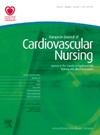Bidirectional relationship between depression and frailty syndrome in Heart Failure patients
IF 3.9
3区 医学
Q2 CARDIAC & CARDIOVASCULAR SYSTEMS
引用次数: 0
Abstract
Introduction Depression and frailty syndrome (FS) are frequently identified in patients with heart failure (HF) and reported in the literature. The co-occurrence of depression and FS has several pathophysiological mechanisms. Moreover, the two constructs overlap in patients with cardiovascular disease. Depression may be difficult to diagnose in patients with HF due to the co-occurrence of FS, and vice versa. It therefore becomes important to establish the direction of the relationship between the presence of depression and FS in patients with HF. Understanding the relationship and causality between these modifiable variables provides an opportunity to increase patient psychological well-being as well as improve clinical outcomes. Aim of the study Determining the direction of the relationship between depression and FS in patients with HF. Material and Methods The study included 250 patients with HF (69% male, 31% female, mean age: M±SD=72.32±6.73). Data were collected during hospitalization. 50% of patients with HFrEF and 50% of patients with HFpEF were included. Depression was assessed using PHQ-9 (The Patient Health Questionnaire-9). The frailty phenotype was determined using the FRIED criteria (weight loss, feelings of exhaustion, decreased physical activity, slowed gait speed, weakened handgrip strength). The diagnosis of frailty was established when a minimum of 3 criteria were met. Data were considered statistically significant at p-value < 0.05. Results FS was identified in 60% of patients with HF. Patients with FS were older (73.58 ± 6.80 vs. 70.39 ±6.16, p-value=0.0002). In HFrEF patients, the mean PHG-9 score was M±SD=5.97±5.65. In HFpEF patients M±SD=5.85±4.52. There were no differences between patients with preserved and reduced left ventricular fraction in terms of PHQ-9 score (p-value=0.585). Univariate analysis showed that each additional score on the PHQ-9 raised the FRIED score by an average of 0.072 points (0.072; 95% CI: 0.051-0.093, p-value< 0.001) and each additional score on the FRIED scale raised the level of depression according to the PHQ-9 by an average of 2.124 points (2.124; 95% CI: 1.499-2.748, p-value<0.001). In the multivariate model, each additional score on the PHQ-9 raised the FRIED scale score by an average of 0.048 points. (0.048; 95% CI: 0.013-0.083, p-value=0.008) and each additional score on the FRIED scale raised the level of depression according to the PHQ-9 by an average of 0.68 points (0.68; 95% CI: 0.179-1.182, p-value=0.008). Conclusions The co-occurrence of FS and mild depression is identified in hospitalized with HF. There is a bidirectional relationship between frailty and depression in patients with HF: depression increases frailty and vice versa. Recognizing these two constructs during hospitalization should involve providing multidisciplinary continuity of care to prevent rehospitalizations.心衰患者抑郁与虚弱综合征之间的双向关系
导言:抑郁和虚弱综合征(FS)经常在心力衰竭(HF)患者中被发现,并在文献中有所报道。抑郁和虚弱综合征的并发具有多种病理生理机制。此外,这两种症状在心血管疾病患者中也有重叠。由于同时存在 FS,HF 患者可能很难诊断出抑郁症,反之亦然。因此,确定心房颤动患者是否存在抑郁和心房颤动之间的关系变得非常重要。了解这些可改变的变量之间的关系和因果关系有助于提高患者的心理健康水平并改善临床疗效。研究目的 确定心房颤动患者抑郁与心房颤动之间关系的方向。材料和方法 研究纳入 250 名高血压患者(69% 为男性,31% 为女性,平均年龄:M±SD=72.32±6.73)。数据在住院期间收集。其中,50%的高频低氧血症患者和 50%的高频低氧血症患者被纳入研究。抑郁采用 PHQ-9(患者健康问卷-9)进行评估。虚弱表型采用 FRIED 标准(体重下降、疲惫感、体力活动减少、步速减慢、手握力减弱)确定。当至少符合 3 项标准时,即可确诊为虚弱。数据的统计学意义以 p 值 < 0.05 为准。结果 60% 的高血压患者被确诊为虚弱。FS患者年龄较大(73.58 ± 6.80 vs. 70.39 ± 6.16,P值=0.0002)。HFrEF患者的平均PHG-9评分为(M±SD)=5.97±5.65。HFpEF患者的M±SD=5.85±4.52。左心室分数保留和降低的患者在 PHQ-9 评分方面没有差异(P 值=0.585)。单变量分析显示,PHQ-9 每增加一个得分,FRIED 评分平均提高 0.072 分(0.072;95% CI:0.051-0.093,p-value<0.001),FRIED 量表每增加一个得分,PHQ-9 显示的抑郁程度平均提高 2.124 分(2.124;95% CI:1.499-2.748,p-value<0.001)。在多变量模型中,PHQ-9 每增加一个得分,FRIED 量表得分平均增加 0.048 分(0.048; 95% CI: 1.499-2.748; p值<0.001)。(0.048; 95% CI: 0.013-0.083, p-value=0.008),FRIED量表每增加一分,PHQ-9显示的抑郁程度平均增加0.68分 (0.68; 95% CI: 0.179-1.182, p-value=0.008)。结论 在心房颤动住院患者中发现了FS和轻度抑郁并存的情况。心房颤动患者的虚弱与抑郁之间存在双向关系:抑郁增加虚弱,反之亦然。在住院期间认识到这两种情况,应提供多学科的连续性护理,以防止再次住院。
本文章由计算机程序翻译,如有差异,请以英文原文为准。
求助全文
约1分钟内获得全文
求助全文
来源期刊

European Journal of Cardiovascular Nursing
CARDIAC & CARDIOVASCULAR SYSTEMS-NURSING
CiteScore
5.10
自引率
10.30%
发文量
247
审稿时长
6-12 weeks
期刊介绍:
The peer-reviewed journal of the European Society of Cardiology’s Council on Cardiovascular Nursing and Allied Professions (CCNAP) covering the broad field of cardiovascular nursing including chronic and acute care, cardiac rehabilitation, primary and secondary prevention, heart failure, acute coronary syndromes, interventional cardiology, cardiac care, and vascular nursing.
 求助内容:
求助内容: 应助结果提醒方式:
应助结果提醒方式:


